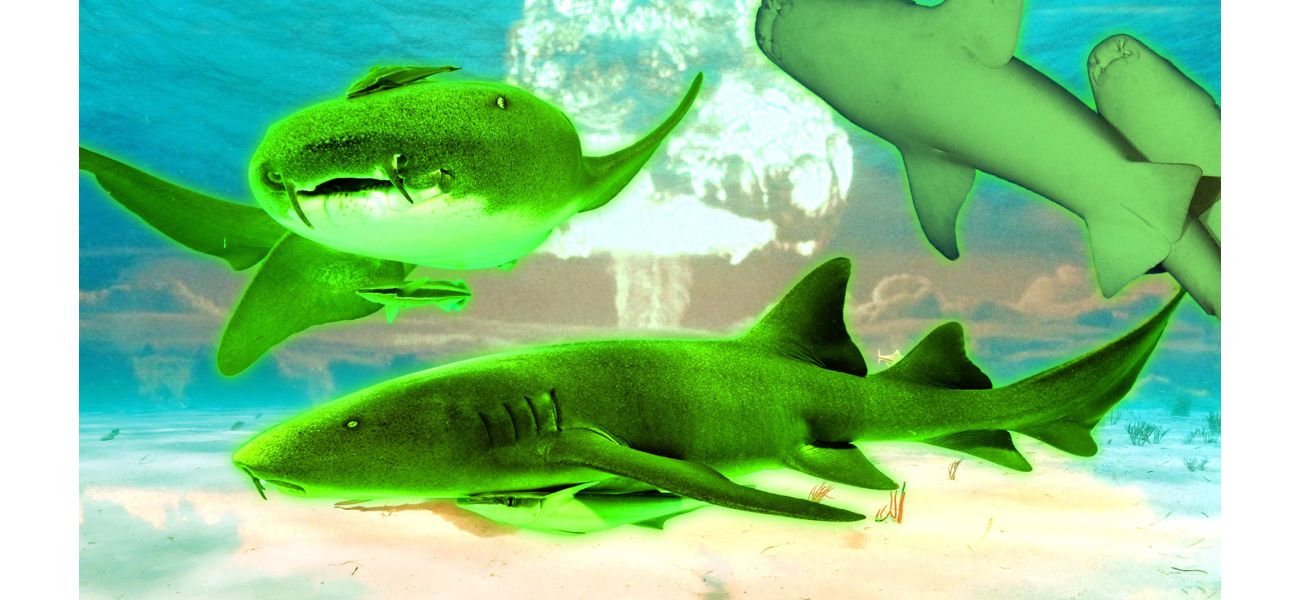An island with mutated sharks, once used for nuclear testing, is now a radioactive area.
October 26th 2024.

When it comes to planning your next vacation, the Marshall Islands may not be at the top of your holiday bucket list. Despite its stunning white sand beaches and picturesque palm trees, this remote ring of coral reefs in the middle of the Pacific Ocean has a dark history that may make you think twice about packing your bags.
In the 1940s and '50s, the United States used two of the Marshall Islands' atolls, Bikini and Enewetak, as testing sites for nuclear bombs. In total, 67 nuclear bombs were detonated, including one that was 1,000 times more powerful than the bomb dropped on Hiroshima. This was all part of Operation Crossroads, a program born out of the anxiety of the Cold War.
At the time, the Marshall Islands were home to around 52,000 people. These 20 small islands, situated between Hawaii and Australia, were the remnants of ancient volcanoes and had been inhabited by humans since the second millennium BCE. However, as the bombs exploded, entire islands were vaporized and craters were gouged into the shallow lagoons, forcing hundreds of people to leave their homes and never return.
Today, the Bikini Atoll, which is part of the Marshall Islands, is known for its unique and diverse wildlife. In fact, it served as the inspiration for the setting of the popular cartoon, Spongebob Squarepants. However, the radiation that still lingers in the water has had a significant impact on the marine life. Sharks with only one dorsal fin and giant coral that grows along the sea floor are just some of the mutations that have been observed.
According to experts, even low levels of radiation can cause genetic mutations in wildlife. The radioactive materials, such as caesium and strontium, break apart DNA and accelerate the process of evolution, leading to what has been described as "unnatural selection". The Baker test, conducted during Operation Crossroads, was specifically designed to test the effectiveness of nuclear weapons against naval ships.
Despite the dangers of radiation, the Marshall Islands were chosen for their remoteness, making it easier for the US military to conduct their tests without interference. However, the consequences of these tests are still being felt today. The water in the Bikini Atoll is undrinkable, and the sealife and plants are not safe for consumption due to the high levels of radiation in the water and soil.
To make matters worse, the Marshallese people also face the threat of rising sea levels due to climate change, which is slowly swallowing up the habitable parts of the islands. The largest nuclear detonation, known as Castle Bravo, took place in Bikini in 1954 and had a devastating impact not only on the island but also on other countries as the radioactive fallout spread as far as Japan, India, and Australia.
Fortunately, the global outcry against the atmospheric testing of nuclear weapons led to a ban in the 1960s. However, this left the US government with one problem: what to do with the radioactive soil and nuclear waste left behind. Their solution was to simply leave it there, as it was deemed too dangerous to move. Today, the Runit Dome, a large concrete slab that was placed over the crater where one of the bombs was detonated, is leaking radioactive material into the surrounding environment.
Despite the efforts of a small caretaker team to maintain the island's infrastructure, the Bikini Atoll remains largely uninhabited. However, the displaced Bikinians continue to fight for their right to return to their home. They have been lobbying the US Congress for funding to clean up and rebuild their islands, and scientists are hopeful that remediation efforts, such as using potassium fertilizer to reduce the amount of radioactive material in the soil, will make it safe for resettlement in the future.
As we look towards the future, it is important to remember the mistakes of the past and take responsibility for the impact of our actions on the environment and the people who call it home. With continued efforts and monitoring, the Bikini Atoll may one day be able to welcome back its people and restore its once vibrant ecosystem.
In the 1940s and '50s, the United States used two of the Marshall Islands' atolls, Bikini and Enewetak, as testing sites for nuclear bombs. In total, 67 nuclear bombs were detonated, including one that was 1,000 times more powerful than the bomb dropped on Hiroshima. This was all part of Operation Crossroads, a program born out of the anxiety of the Cold War.
At the time, the Marshall Islands were home to around 52,000 people. These 20 small islands, situated between Hawaii and Australia, were the remnants of ancient volcanoes and had been inhabited by humans since the second millennium BCE. However, as the bombs exploded, entire islands were vaporized and craters were gouged into the shallow lagoons, forcing hundreds of people to leave their homes and never return.
Today, the Bikini Atoll, which is part of the Marshall Islands, is known for its unique and diverse wildlife. In fact, it served as the inspiration for the setting of the popular cartoon, Spongebob Squarepants. However, the radiation that still lingers in the water has had a significant impact on the marine life. Sharks with only one dorsal fin and giant coral that grows along the sea floor are just some of the mutations that have been observed.
According to experts, even low levels of radiation can cause genetic mutations in wildlife. The radioactive materials, such as caesium and strontium, break apart DNA and accelerate the process of evolution, leading to what has been described as "unnatural selection". The Baker test, conducted during Operation Crossroads, was specifically designed to test the effectiveness of nuclear weapons against naval ships.
Despite the dangers of radiation, the Marshall Islands were chosen for their remoteness, making it easier for the US military to conduct their tests without interference. However, the consequences of these tests are still being felt today. The water in the Bikini Atoll is undrinkable, and the sealife and plants are not safe for consumption due to the high levels of radiation in the water and soil.
To make matters worse, the Marshallese people also face the threat of rising sea levels due to climate change, which is slowly swallowing up the habitable parts of the islands. The largest nuclear detonation, known as Castle Bravo, took place in Bikini in 1954 and had a devastating impact not only on the island but also on other countries as the radioactive fallout spread as far as Japan, India, and Australia.
Fortunately, the global outcry against the atmospheric testing of nuclear weapons led to a ban in the 1960s. However, this left the US government with one problem: what to do with the radioactive soil and nuclear waste left behind. Their solution was to simply leave it there, as it was deemed too dangerous to move. Today, the Runit Dome, a large concrete slab that was placed over the crater where one of the bombs was detonated, is leaking radioactive material into the surrounding environment.
Despite the efforts of a small caretaker team to maintain the island's infrastructure, the Bikini Atoll remains largely uninhabited. However, the displaced Bikinians continue to fight for their right to return to their home. They have been lobbying the US Congress for funding to clean up and rebuild their islands, and scientists are hopeful that remediation efforts, such as using potassium fertilizer to reduce the amount of radioactive material in the soil, will make it safe for resettlement in the future.
As we look towards the future, it is important to remember the mistakes of the past and take responsibility for the impact of our actions on the environment and the people who call it home. With continued efforts and monitoring, the Bikini Atoll may one day be able to welcome back its people and restore its once vibrant ecosystem.
[This article has been trending online recently and has been generated with AI. Your feed is customized.]
[Generative AI is experimental.]
0
0
Submit Comment





